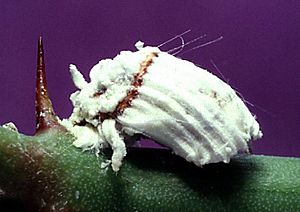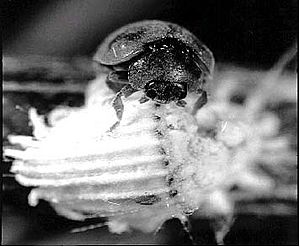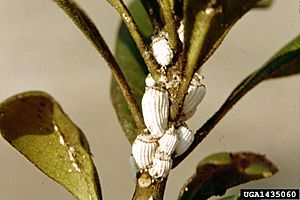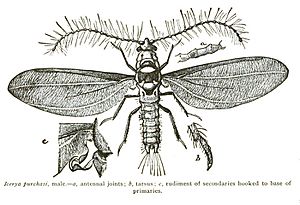Icerya purchasi facts for kids
Quick facts for kids Icerya purchasi |
|
|---|---|
 |
|
| Icerya purchasi female | |
| Scientific classification | |
| Genus: |
Icerya
|
| Species: |
purchasi
|
| Synonyms | |
|
|
The Icerya purchasi is commonly known as the cottony cushion scale. It is a tiny scale insect that eats many types of woody plants. It especially likes Citrus trees (like oranges and lemons) and Pittosporum plants.
This insect was first described in 1878. It was found in New Zealand where it was a pest on a plant called kangaroo acacia. A scientist named W.M. Maskell named it after Dr. Purchas, who he believed found it first. The cottony cushion scale originally comes from Australia. Today, you can find it all over the world, especially where citrus fruits are grown.
Contents
Life cycle
These insects usually live on the twigs and branches of plants. An adult cottony cushion scale is about 5 millimeters long. It is reddish-brown with black hairs and is oval-shaped.
When it grows up, the insect stays in one spot. It sticks itself to the plant using a waxy substance. Then, it creates a white egg sac. This sac is made of waxy grooves and holds hundreds of red eggs. The egg sac can become two or three times longer than the insect's body!
When the eggs hatch, tiny nymphs come out. These young insects are the main way the scales spread. They can be carried by the wind or crawl to new places. Young nymphs feed on the veins of leaves and small twigs. This is when they cause most of the damage to the plant.
As they grow, they shed their old skin and waxy coverings. This waxy stuff is how they got their common name. Unlike many other scale insects, cottony cushion scales can move a little bit at all stages of their lives. Older nymphs move to bigger twigs and then to branches and the main trunk. How fast they grow depends a lot on the temperature. They grow slower in cold weather and faster in warm weather.
Besides eating the plant's sap, these insects also make a sticky liquid called honeydew. A black fungus called sooty mold often grows on this honeydew. This mold can hurt the plant even more. Some ants also like to eat the honeydew.
Reproduction
Cottony cushion scales have an interesting way of reproducing. Most of them are hermaphrodites. This means one insect has both male and female parts. True males are very rare. Sometimes, you won't find any males in a group of these insects.
A hermaphrodite can fertilize its own eggs. When this happens, it will only produce more hermaphrodites. If a male mates with a hermaphrodite, they can produce both males and hermaphrodites. Pure females (insects with only female parts) are not known to exist in this species.
Biological control

The cottony cushion scale is famous for being one of the first big successes in biological control. Biological control means using natural enemies to fight pests.
In 1888-1889, a special ladybird beetle was brought to California. This beetle is called the vedalia ladybird (Rodolia cardinalis). It was brought by C. V. Riley, who worked for the USDA. The vedalia ladybird quickly ate many cottony cushion scales. This saved the growing citrus industry in California from this harmful pest.
Another natural enemy, a parasitic fly called Cryptochetum iceryae, was also brought to California. This fly helps control the scales too.
Using bug sprays (insecticides) is usually not suggested for these pests. This is because the natural enemies do a great job. Some insecticides, like Imidacloprid, don't even work on the cottony cushion scale. But they are very harmful to the helpful vedalia ladybirds.
- General
(originally published as 20th Century Insect Control in the July 1992 issue of Agricultural Research magazine)
See also
 In Spanish: Cochinilla acanalada para niños
In Spanish: Cochinilla acanalada para niños



